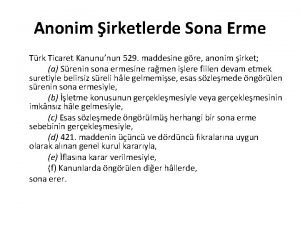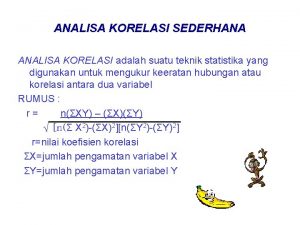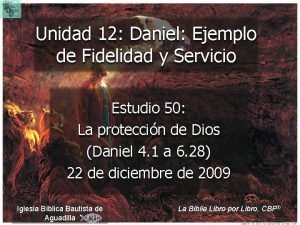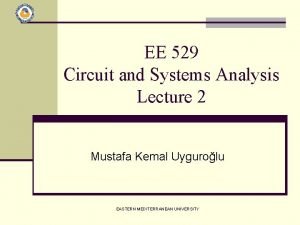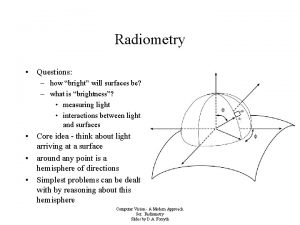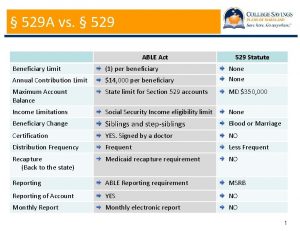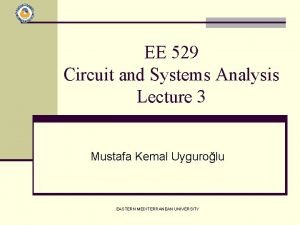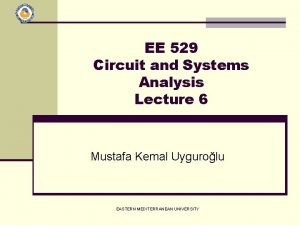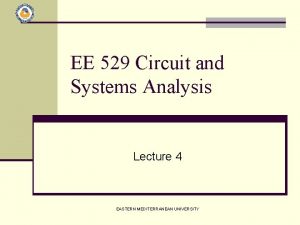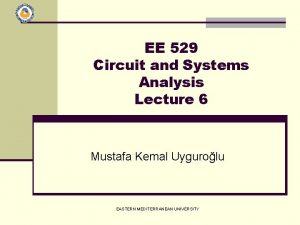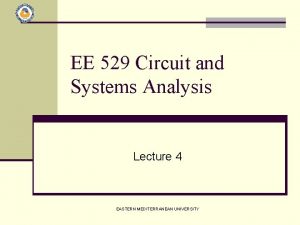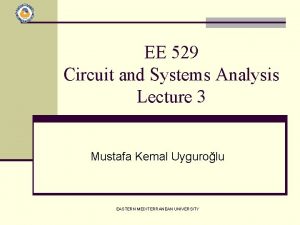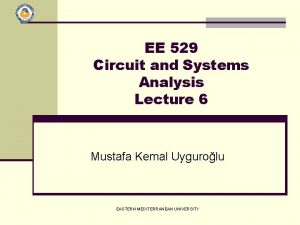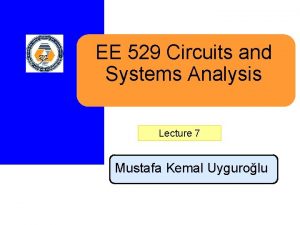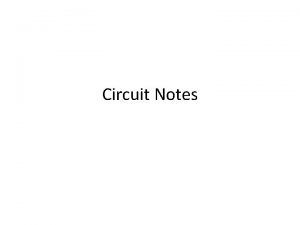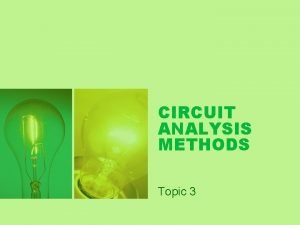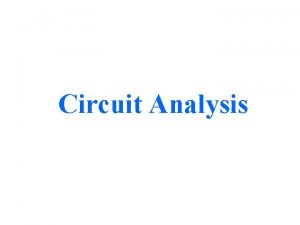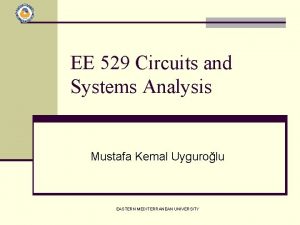EE 529 Circuit and Systems Analysis Lecture 6






























- Slides: 30

EE 529 Circuit and Systems Analysis Lecture 6 Mustafa Kemal Uyguroğlu EASTERN MEDITERRANEAN UNIVERSITY

Mathematical Models of Electrical Components A. Nullator a b

Mathematical Models of Electrical Components B. Norator a b Nullator and Norator are conceptual elements. They are used to represent some electrical elements in different ways.

Mathematical Models of Electrical Components C. Three Terminal and two-port Circuit Elements C. 1 TRANSISTOR e c 2 1 b Ebers-Moll Equations

Mathematical Models of Electrical Components C. Three Terminal and two-port Circuit Elements C. 2 IDEAL TRANSFORMER a b 2 1 c

Mathematical Models of Electrical Components C. Three Terminal and two-port Circuit Elements C. 2 IDEAL TRANSFORMER a c 1 2 b d

Mathematical Models of Electrical Components C. Three Terminal and two-port Circuit Elements C. 3 IDEAL GYRATOR a b 2 1 c

Mathematical Models of Electrical Components C. Three Terminal and two-port Circuit Elements C. 3 IDEAL GYRATOR a c 1 2 b d

Mathematical Models of Electrical Components Representation of Ideal Transformer with Dependent Sources a c 1 2 b d

Mathematical Models of Electrical Components Representation of Ideal Transformer with Dependent Sources i 1 + v 1 -

Mathematical Models of Electrical Components Representation of Ideal Transformer with Dependent Sources

Mathematical Models of Electrical Components Representation of Ideal Gyrator with Dependent Sources

Mathematical Models of Electrical Components Representation of Ideal Gyrator with Dependent Sources

Mathematical Models of Electrical Components Operational Amplifier a 1 1 a 2 a 3 2 a 0 3

Mathematical Models of Electrical Components Operational Amplifier a 1 1 a 2 a 3 2 3 a 0 A: open loop gain, very big!

Mathematical Models of Electrical Components Operational Amplifier a 3 a 1 1 3 a 0 A: open loop gain, very big!

Mathematical Models of Electrical Components • Representation of OP-AMP with Nullator and Norator.

Analysis of Circuits Containing Multi-terminal Components n The terminal equations of resistors are n The terminal equations of multi-terminal components are similar to two-terminal components but the coefficient matrices are full.

Analysis of Circuits Containing Multi-terminal Components where vb : branch voltages vc : Chord voltages ib : branch currents ic : Chord currents

Analysis of Circuits Containing Multi-terminal Components (A) Branch Voltages Method By using the terminal equations of the multiterminal components, the above equation can be written as

Analysis of Circuits Containing Multi-terminal Components n On the other, the chord voltages can be written in terms of branch voltages by using the fundamental circuit equations. n If Eq. (2) is substituted into (1) and the known quantities are collected on the right hand side then the following equation is obtained:

Analysis of Circuits Containing Multi-terminal Components

Analysis of Circuits Containing Multi-terminal Components n Example : In the following figure, the circuit contains a 3 -terminal component. The terminal equation of the 3 -terminal component is: n Using the branch voltages method, obtain the circuit equations IS b a VS 2 1 c (Ra) 2 1 c (Rb)

Analysis of Circuits Containing Multi-terminal Components n Example : In the following figure, the circuit contains a 3 -terminal component. The terminal equation of the 3 -terminal component is: n Using the branch voltages method, obtain the circuit equations IS b a VS 2 1 c (Ra) 2 1 c (Rb)

Analysis of Circuits Containing Multi-terminal Components n The fundamental cut-set equations for tree branches 1 and 2: IS b a VS (Ra) 2 1 c (Rb) The terminal equations of the resistors: Subst. of Eqs. (3) and (1) into (2) yields:

Analysis of Circuits Containing Multi-terminal Components n va and vb can be expressed in terms of branch voltages using fundamental circuit equations. n Subst. of Eq. (5) into (4) gives:

Analysis of Circuits Containing Multi-terminal Components n Example : In the following figure, the circuit contains a 2 -port gyrator and a 3 -terminal voltage controlled current source. The terminal equations of these components are: n Using the branch voltages method, obtain the circuit equations

Analysis of Circuits Containing Multi-terminal Components (Rb) 3 (Ra) 1 2 Vs 4

Analysis of Circuits Containing Multi-terminal Components (Rb) 3 (Ra) 1 2 4 The terminal equations of the resistors: Vs Subst. of Eqs. (3) and (1) into (2) yields:

Analysis of Circuits Containing Multi-terminal Components nva , vb and v 3 can be expressed in terms of branch voltages using fundamental circuit equations. • Subst. of Eq. (5) into (4) gives:
 01:640:244 lecture notes - lecture 15: plat, idah, farad
01:640:244 lecture notes - lecture 15: plat, idah, farad What is a incomplete circuit
What is a incomplete circuit Venn diagram of reflection and refraction
Venn diagram of reflection and refraction Blood circulation system diagram
Blood circulation system diagram Wa 529 plan
Wa 529 plan Coverdell vs 529 comparison chart
Coverdell vs 529 comparison chart Fidelity advisors 529
Fidelity advisors 529 Texas 529
Texas 529 Consentimiento informado definicion
Consentimiento informado definicion Edvest 529
Edvest 529 Bright directions illinois
Bright directions illinois Ttk 529
Ttk 529 X²-46+529=0
X²-46+529=0 La fidelidad de daniel a dios
La fidelidad de daniel a dios Ee-529
Ee-529 Ee-529
Ee-529 Father of graph theory
Father of graph theory Cs 529
Cs 529 Bright direction 529
Bright direction 529 Montana college savings
Montana college savings Bright direction 529
Bright direction 529 Advanced operating system notes
Advanced operating system notes Lecture sound systems
Lecture sound systems Lecture sound systems
Lecture sound systems Circuit in parallel vs series
Circuit in parallel vs series Types of electrical circuits
Types of electrical circuits Phet circuit construction kit
Phet circuit construction kit Series vs parallel circut
Series vs parallel circut Short circuit examples
Short circuit examples Series parallel circuit current
Series parallel circuit current Exploratory data analysis lecture notes
Exploratory data analysis lecture notes











